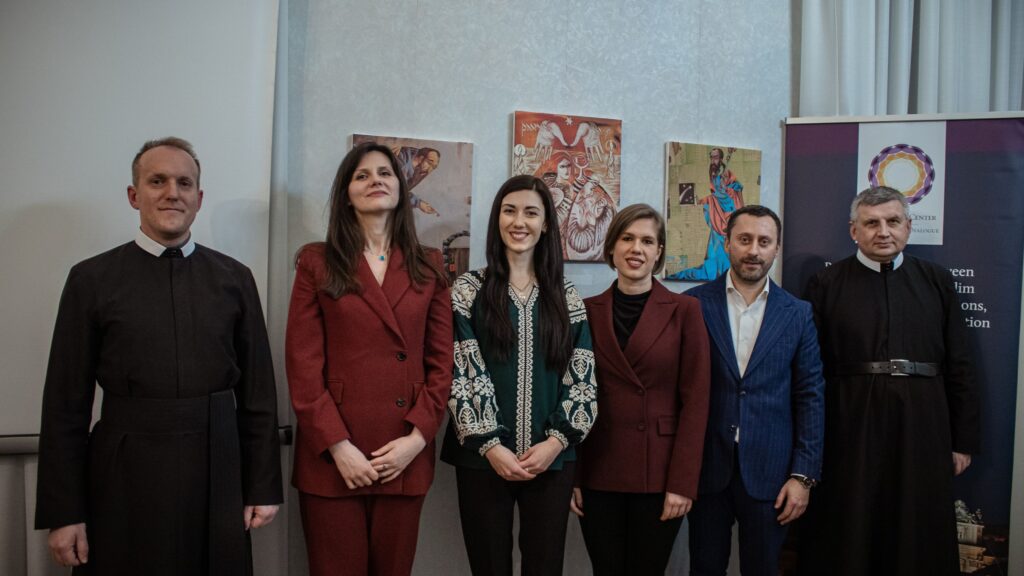On February 18, 2023 seven Ukrainian artists—Myroslav Yasinskyi, Rustem Skybin, Yevgen Kotlyar, Violetta Terlyha, Vadym Koltun, Lyubov Yakimenko and Oleg Omelchenko—were represented at an interfaith art exhibition titled “Civilization of Love,” curated by JPII Leader Bogdana Katarzhuk (Cohort XIV, Ukraine).
The event opened with a seminar, “Dialogue in Times of War,” in which three invited speakers, JPII Center leaders—Olena Komisarenko (Cohort XIV, Ukraine), Vladimer Narsia (Cohort XIV, Georgia), and Nataliia Pavlyk (Cohort XII, Ukraine)—were involved in a conversation around war, art, and interfaith dialogue. The seminar was moderated by Taras Dzyubanskyy, Senior Alumni Advisor to the JPII Center. The event was hosted at the Pontifical Ukrainian College of St. Josaphat and funded by the John Paul II Center Grants Program.
In this seminar, Olena Komisarenko presented an intervention entitled “Interreligious and interconfessional collaboration in the times of war in Ukraine.” She shares an excerpt here: “To commemorate the meeting of the All-Ukrainian Council of Churches and Religious Organizations with the Holy Father on January 25, 2023 in Rome, representatives of the council presented Pope Francis with a painting depicting peaceful Ukraine, painted by Ukrainian children. A piece of art in this situation was an expression of the spirit of true fraternal unity and the spirit of recognition of religious plurality in the society of peaceful Ukraine we are dreaming of, and we are praying for.”
The participants of the opening seminar explored the issues of interreligious dialogue in the times of war and the existential search for God by a person. The desire of Ukrainians to build a society based on the concept of a “civilization of love” and through interfaith dialogue was expressed. Additionally, the question of whether the mutual aid of different religions representatives during wartime is a dialogue about values or a concerted effort to survive was also raised along with the question about the practical ways interreligious dialogue may pertain not only to diplomatic issues but also to the daily challenges people are facing because of war.
“The tragic anniversary of the full-scale war against Ukraine should remind Western society of the tragedy and grief of our people,” comments Taras Dzyubanskyy, “who, despite all the suffering, remain a people of freedom and resilience. Educational, cultural and social processes are continuing, and for this we owe much to the role of churches and religious organizations. Intellectual discussions continue and we are confident that this is a great contribution to the victory in the fight against the forces of evil.”
The “Civilization of Love” exhibition, which was open daily from February 18 to February 23, was dedicated to Ukrainian realities of war and interreligious dialogue. Some of the artists included: Muslim Crimea Rustem Skybin, who depicts the Easter egg painted in an Islamic style with the images of Czech hedgehogs which are at the same time Qur’an stands; a Jewish artist Vadym Koltun, who rethinks and depicts the “Crucifixion” of Ukrainians made by Russian missiles; and a Christian artist, Myroslav Yasinskyi, who asks the Angels present in all three religions to “save and protect” us.
Nataliia Pavlyk shared the “Interfaithing Humanity” Colouring Book that she created with the support of a grant from the JPII Center. “I was excited to share how art and creativity can contribute to inter- and intra-religious peacebuilding in times of war when other means of dialogue are not so efficient,” she expresses.
Gavin D’Costa, Emeritus Professor of Catholic Theology at the University of Bristol and Visiting Professor of Interreligious Dialogue at the Pontifical University of St Thomas Aquinas, remarks: “This exhibition of Ukrainian artists from three different religions testifies to the soaring human spirit, even in the darkest times. Some of the artists daringly break traditional iconographic boundaries to express the solidarity—and hope—of inter-religious aspirations in a time of war.”
Thomas Cattoi, Associate Professor of Christology and Cultures at Graduate Theological Union and Visiting Professor at the Angelicum, also offers a reflection on this event: “Interreligious dialogue and comparative theology often choose textual analysis as their starting point […] As our culture becomes increasingly visual, however, it is high time to experiment with different approaches for dialogue, and the visual arts provide one such framework. This exhibition and the interreligious coloring book show how the visual, artistic encounter between traditions opens up new horizons for interreligious understanding.”
“The grief unequivocally unites the people,” concludes Bogdana Katarzhuk, the curator of this exhibition, “but only love to God, the state and other people gives them the strength to act and keep standing.”

